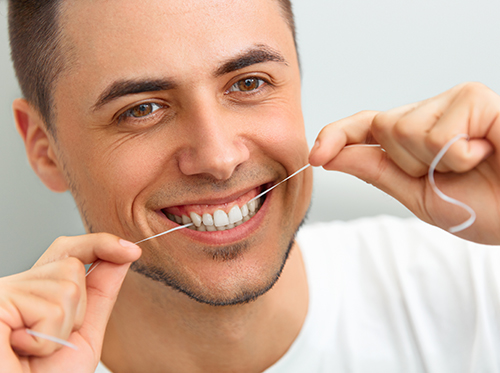February 21st, 2017

Flossing is one of the most important parts of your oral care routine. Many patients know they need to do it but find it difficult to fit into their busy lives. Well, here's the good news: flossing once a day is enough if you're doing a good job!
Some patients like to brush before they floss and others like to floss before they brush. Some like to floss in the morning when they have more energy, others like to floss at night so they can go to bed with a clean mouth. Don't get hung up on any of this, the important thing is that you floss and floss effectively no matter when you do it.
Effective flossing contributes to oral health in these ways:
- It reduces the chance of cavities between teeth, since cavities can only form on teeth covered with dental plaque and you're scraping that plaque away when you floss.
- Along with brushing, it reduces the amount of time the plaque is left on your teeth, allowing them to be in a state of healing and remineralization for longer.
- It removes plaque that accumulates at or below the gum line, aiding in the prevention of gum disease.
As you can see, flossing offers many benefits for such a simple and inexpensive technique. So if you're still wondering how much to floss, don't worry about it. Don't mistake the frequency of your flossing with the effectiveness of it. Choose a dental floss that you like and one time during the day when you can floss thoroughly and just do it! If you need more tips on how to floss correctly, ask Dr. Cody Henriksen or any member of our Sioux Falls, SD team—we'd be glad to help you pick up this healthy habit!
February 14th, 2017

Nobody likes bad breath, and although it can sometimes be difficult to tell if you have it, it is always better to practice good oral health than risk having a smelly mouth. There are many ways to reduce or eliminate bad breath, some are definitely more effective and longer lasting than others. Check out ways to do so below.
Floss Regularly
As difficult as it can be to remember to floss regularly, when it comes to bad breath, flossing is one of the easiest and most cost effective ways to freshen your mouth. See, flossing reduces the plaque and bacteria found in areas of your mouth that a toothbrush simply can't reach, and in turn, it rids your mouth of the smell associated with that bacteria. While flossing may not eliminate bad breath on its own, if you do it along with other health oral hygiene habits like brushing, then you may just develop a fresher smelling mouth.
Use Mouthwash
Using some sort of mouthwash can really freshen up your breath, especially if you find it still smells after brushing and flossing. There is a wide variety of mouthwash products on the market, however, you can also create your own by simply using baking soda mixed with water.
Always Brush after You Sleep
Whether after taking a nap, or having a full night of sleep, you will want to brush your teeth in order to reduce bad breath. The truth is, bacteria accumulates in your mouth while you are sleeping (even during a short nap) and that is ultimately the source of bad breath. So next time you wake from a good slumber, give your mouth some brushing and you will find it makes a big difference in the freshness of your breath.
There are many ways to freshen your breath beyond just using gum or mints, the above mentioned are just a few for you to try. Test them out and you will likely find your bad breath problem is solved, or at least considerably reduced. Of course, you can always ask Dr. Cody Henriksen at your next visit to our Sioux Falls, SD office.
February 7th, 2017

The use of mini dental implants (MDIs) is on the rise. MDIs are about the diameter of a toothpick (1.8 to 2.9 millimeters with lengths between ten to 18 millimeters) and are primarily used to secure loose upper or lower dentures or partial dentures.
MDIs are particularly useful for patients who suffer from osteoporosis or otherwise aren't well enough to get the bone grafts sometimes required by traditional dental implants. Their diminutive size also allows them to replace smaller teeth where the placement of a dental implant isn't feasible or called for.
Some of the benefits of MDIs include:
- The procedure is quicker and less invasive – Since MDIs don’t require the cutting of gum tissue or sutures, Dr. Cody Henriksen can place the implant quickly, resulting in a shorter healing process. MDIs go directly through the gum tissue and into the jawbone.
- Lower cost – MDIs run in the range of $500 to $1500, whereas traditional dental implants can cost around $4,000.
- Less risk of surgical error – Since MDIs don't go as deep into the tissue or jawbone, there is less risk of surgical error, like hitting a nerve or sinus cavity.
- Can be used in thinner areas of the jawbone – Since MDIs don't require as much gum tissue or jawbone, they can be used in thinner areas of the jawbone, where a traditional dental implant would require a bone graft.
Although there are many advantages to MDIs, they aren't for everyone or every situation. There are some drawbacks, especially when it comes to their durability and stability. MDIs also haven't been studied nearly as much as dental implants.
Whatever your situation, it's best to speak with Dr. Cody Henriksen about your options, and whether an MDI or a dental implant would work best for your specific case. Schedule an appointment at our Sioux Falls, SD office to learn more.
January 31st, 2017

In our continuing efforts to provide the most advanced technology and highest quality care available to our patients at Dental Comfort Center, we proudly screen our patients for oral cancer. The fact is, every hour of every day in North America, someone dies of oral cancer, which is the sixth most common diagnosed form of the disease. The five-year survival rate is only 50 percent, and oral cancer is one of the few cancers whose survival rate has not improved.
Oral cancer can occur on the lips, gums, tongue, inside lining of the cheeks, roof of the mouth, and the floor of the mouth. Symptoms of oral cancer may include a sore in the throat or mouth that bleeds easily and does not heal, a red or white patch that persists, a lump or thickening, ear pain, a neck mass, or coughing up blood. Difficulties in chewing, swallowing, or moving the tongue or jaws are often late symptoms. While there is no way to predict exactly which individuals will get oral cancer, there are some potential causes we want you to know about. In some cases, it is possible to minimize these risk factors.
- Age (most patients diagnosed with oral cancer are over the age of 40)
- Tobacco use, either from cigarettes or smokeless chewing tobacco
- Excessive alcohol consumption
- Persistent viral infections, such as HPV16
- A diet lacking or low in fruits and vegetables
Finding out you have oral cancer can be devastating news. If you are concerned that you might be at risk for developing oral cancer, talk to us about screenings and other things you can do to reduce your risk. Through a routine visual inspection, Dr. Cody Henriksen and our team at Dental Comfort Center can often detect premalignant abnormalities and cancer at an early stage, when treatment is both less expensive and more successful, and can potentially save your life. Ask Dr. Cody Henriksen and our team at Dental Comfort Center about a screening at your next appointment!



